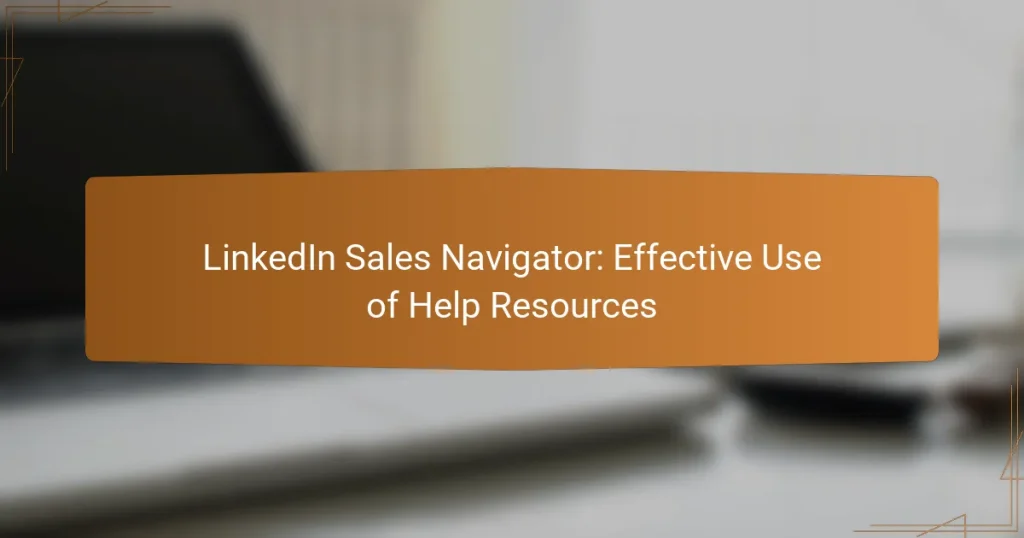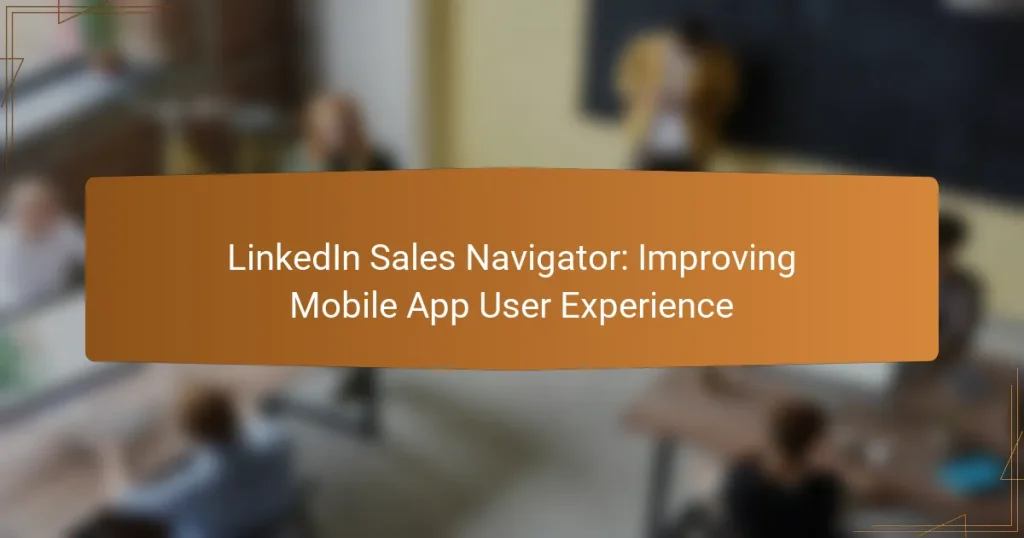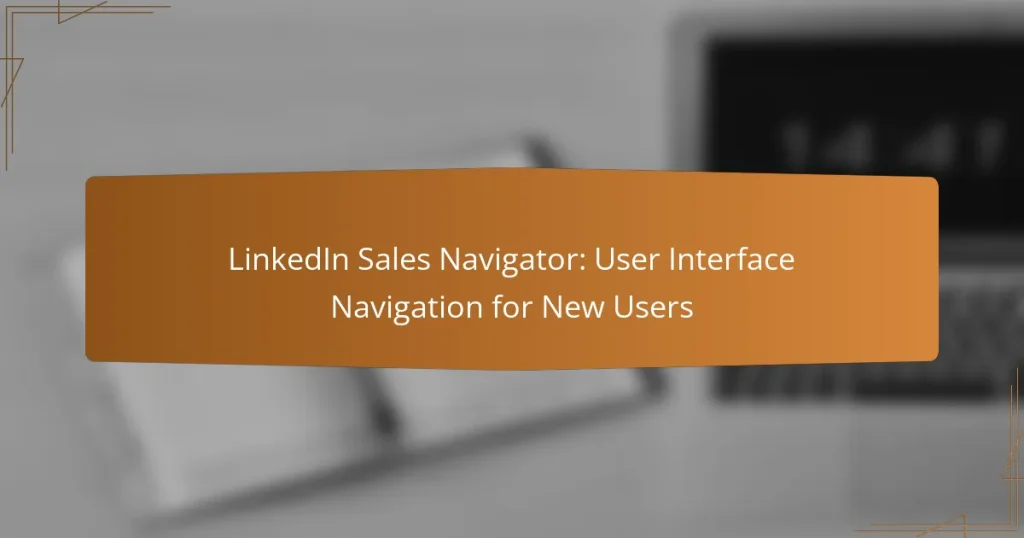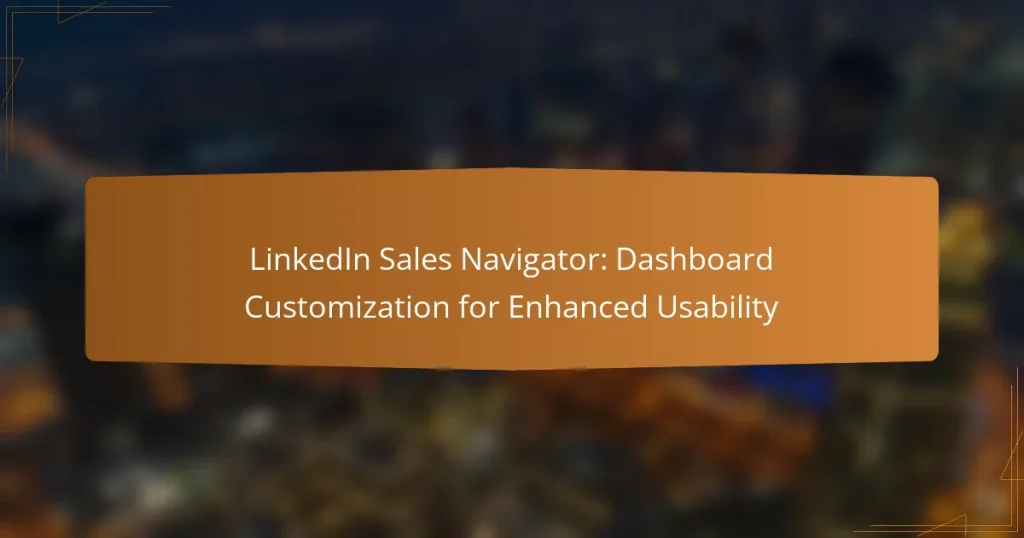LinkedIn Sales Navigator significantly improves the user experience for sales professionals by offering advanced tools tailored for lead generation and personalized communication. With features like advanced search filters and InMail messaging, it streamlines the process of connecting with potential clients, making sales workflows more efficient. Its integration with LinkedIn’s extensive professional network provides unique insights that enhance relationship management and lead generation.
LinkedIn Sales Navigator: Improving Mobile App User Experience
LinkedIn Sales Navigator: User Interface Navigation for New Users
LinkedIn Sales Navigator: Insights from User Reviews
LinkedIn Sales Navigator: Adapting to User Experience Changes
LinkedIn Sales Navigator: Dashboard Customization for Enhanced Usability
LinkedIn Sales Navigator: User Feedback Trends and Insights
How can LinkedIn Sales Navigator enhance user experience?
LinkedIn Sales Navigator enhances user experience by providing advanced tools for lead generation, personalized communication, and efficient sales workflows. These features help sales professionals connect with potential clients more effectively and streamline their sales efforts.
Improved lead targeting
LinkedIn Sales Navigator allows users to refine their lead targeting through advanced search filters. Users can specify criteria such as industry, company size, and geographic location, making it easier to identify high-potential prospects. This targeted approach increases the likelihood of successful outreach and engagement.
For example, a sales representative can filter leads by specific job titles within a certain region, ensuring that their efforts are focused on the most relevant contacts. This precision can lead to higher conversion rates and more efficient use of time and resources.
Personalized outreach strategies
The platform enables personalized outreach by providing insights into leads’ activities and interests. Users can view updates, shared content, and mutual connections, allowing them to tailor their messages accordingly. Personalization can significantly improve response rates and foster stronger relationships.
For instance, referencing a lead’s recent post or shared article in a message can create a more engaging and relevant conversation. This approach not only demonstrates genuine interest but also enhances the overall user experience by making interactions feel more authentic.
Streamlined sales processes
LinkedIn Sales Navigator streamlines sales processes by integrating with CRM systems and offering tools for tracking interactions. Users can log notes, set reminders, and manage follow-ups directly within the platform, reducing the time spent on administrative tasks. This efficiency allows sales teams to focus more on building relationships and closing deals.
Additionally, the platform’s analytics and reporting features provide valuable insights into sales performance, helping users identify trends and adjust strategies as needed. By leveraging these tools, sales professionals can enhance their productivity and effectiveness in a competitive market.
What features of LinkedIn Sales Navigator improve usability?
LinkedIn Sales Navigator enhances usability through its tailored features designed for sales professionals. Key functionalities such as advanced search filters, InMail messaging, and real-time insights streamline the process of finding and connecting with potential clients.
Advanced search filters
Advanced search filters allow users to narrow down their search for leads based on specific criteria such as industry, company size, and geography. This targeted approach helps sales professionals identify the most relevant prospects quickly.
Utilizing these filters can significantly increase efficiency. For example, a user can filter by location to find leads within a certain radius, making it easier to focus on local opportunities.
InMail messaging capabilities
InMail messaging enables users to directly reach out to prospects who are not in their network. This feature is particularly useful for initiating conversations with decision-makers and increasing response rates.
Sales Navigator users can send a limited number of InMails each month, which encourages thoughtful outreach. Crafting personalized messages can enhance engagement and improve the chances of a positive response.
Real-time insights and updates
Real-time insights provide users with timely information about their leads, such as job changes or company news. This feature allows sales professionals to tailor their outreach based on current events, making interactions more relevant.
Staying updated with these insights can help in identifying the right moment to connect or follow up. For instance, if a prospect has recently been promoted, it may be an opportune time to reach out and congratulate them while introducing your services.
How does LinkedIn Sales Navigator compare to other sales tools?
LinkedIn Sales Navigator stands out among sales tools due to its extensive integration with LinkedIn’s professional network, providing unique insights and connections. While other tools offer various features, Sales Navigator excels in lead generation and relationship management through its vast database of professionals.
Comparison with HubSpot Sales
HubSpot Sales focuses on inbound marketing and automation, making it ideal for businesses looking to attract leads organically. In contrast, LinkedIn Sales Navigator is more effective for direct outreach and personalized engagement, leveraging LinkedIn’s network for targeted prospecting.
For example, HubSpot offers robust CRM capabilities and email tracking, while Sales Navigator provides advanced search filters and lead recommendations based on user behavior. Companies may choose HubSpot for its marketing automation features, but Sales Navigator is preferable for sales teams prioritizing relationship building.
Comparison with ZoomInfo
ZoomInfo specializes in providing detailed company and contact information, making it a strong competitor for data-driven sales strategies. However, LinkedIn Sales Navigator enhances this with social selling features, allowing users to engage directly with prospects through their LinkedIn profiles.
ZoomInfo’s strength lies in its extensive database and analytics tools, which can be beneficial for market research. Conversely, Sales Navigator’s integration with LinkedIn allows for real-time updates on leads, making it easier to build rapport and maintain relationships over time.
Comparison with Salesforce
Salesforce is a comprehensive CRM platform that offers extensive customization and automation capabilities. While it provides a broad range of sales and marketing tools, LinkedIn Sales Navigator complements it by enhancing lead discovery and social engagement.
Salesforce users can benefit from integrating Sales Navigator to access LinkedIn’s network directly within their CRM. This integration allows sales teams to leverage LinkedIn’s insights while managing their customer relationships effectively, creating a more holistic sales approach.
What are the pricing options for LinkedIn Sales Navigator?
LinkedIn Sales Navigator offers various pricing options tailored to different user needs, primarily through monthly and annual subscriptions. Understanding these options can help you choose the plan that best fits your sales strategy and budget.
Monthly subscription rates
The monthly subscription rates for LinkedIn Sales Navigator typically range from around $80 to $100 per month, depending on the specific plan you select. These plans include features such as advanced search capabilities, lead recommendations, and CRM integration.
It’s essential to evaluate what features are most beneficial for your sales process when considering a monthly subscription. If you plan to use the service for a short period, this option may be more suitable despite the higher cost compared to annual plans.
Annual subscription discounts
LinkedIn Sales Navigator offers discounts for annual subscriptions, which can save users a significant amount over the course of the year. Generally, opting for an annual plan can reduce the monthly cost to approximately $70 to $80 per month.
Choosing an annual subscription is a practical option for those committed to long-term sales efforts. Be sure to assess your anticipated usage to ensure this commitment aligns with your sales goals.
Free trial availability
LinkedIn Sales Navigator provides a free trial period, typically lasting 30 days, allowing potential users to explore the platform’s features without any financial commitment. This trial is an excellent opportunity to evaluate how well the tool fits your sales needs.
During the free trial, take advantage of all available features to determine if the service meets your expectations. Remember to cancel before the trial ends if you decide not to continue with a paid subscription to avoid being charged.
What prerequisites should users consider before using LinkedIn Sales Navigator?
Before using LinkedIn Sales Navigator, users should ensure they have an appropriate LinkedIn account and a solid understanding of sales processes. These prerequisites will enhance the effectiveness of the tool and improve user experience.
LinkedIn account requirements
To access LinkedIn Sales Navigator, users must have a LinkedIn account, preferably a premium subscription. Free accounts may have limited access to features, which can hinder the ability to leverage the full capabilities of Sales Navigator.
Additionally, users should ensure their LinkedIn profile is complete and professional. A well-optimized profile helps in establishing credibility and increases the chances of successful connections with potential leads.
Understanding of sales processes
A strong grasp of sales processes is essential for maximizing the benefits of LinkedIn Sales Navigator. Users should be familiar with lead generation, nurturing, and closing techniques to effectively utilize the tool’s features.
Understanding key sales metrics and customer relationship management (CRM) principles can also enhance the user experience. This knowledge allows users to set realistic goals and measure the success of their outreach efforts effectively.
What are the best practices for maximizing LinkedIn Sales Navigator?
To maximize LinkedIn Sales Navigator, focus on maintaining updated lead lists and effectively utilizing saved searches. These practices enhance your ability to connect with potential clients and streamline your outreach efforts.
Regularly updating lead lists
Regularly updating lead lists is crucial for keeping your sales efforts relevant and effective. This involves reviewing your leads frequently to ensure they align with your current business goals and market conditions.
Consider setting a schedule, such as weekly or monthly, to revisit and refresh your lead lists. Remove leads that are no longer viable and add new prospects that fit your ideal customer profile. This practice helps maintain a high-quality pipeline.
Utilizing saved searches
Utilizing saved searches allows you to streamline your prospecting process by saving specific search criteria that yield the best results. This feature enables you to quickly access potential leads that match your target demographics, industries, or job titles.
To make the most of saved searches, regularly review and adjust your criteria based on changing market trends or business objectives. Additionally, consider setting up alerts for new leads that fit your saved searches, ensuring you never miss an opportunity.






